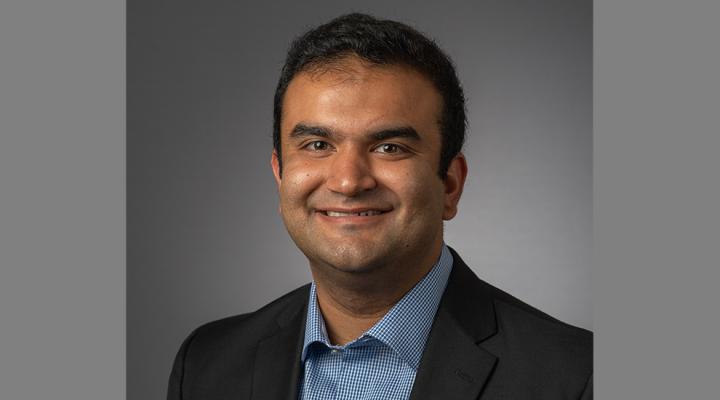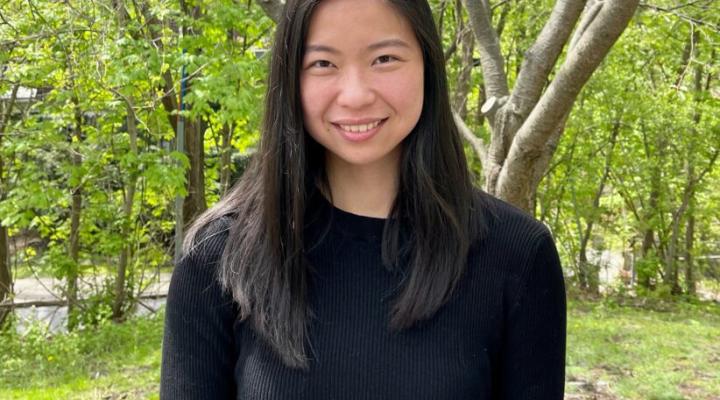“Insulating” metal oxides may not seem to be the best candidate for high performance energy storage devices due to the sluggish movement of electrons in the material. But Anuj Bhargava, a doctoral student in the Richard Robinson Group at Cornell’s School of Materials Science and Engineering (MSE), discovered that varying the ratio of two commonly used insulating oxides (Co3O4 and Mn3O4) can lead to an order of magnitude enhancement in the performance of supercapacitors. In the quest to explain this anomalous behavior Anuj realized that the current “small-polaron hopping model,” which described the movement of electrons in metal oxides is outdated and inaccurate. “The conventional model introduced almost 60 years ago, was developed for binary oxides, i.e., just one cation-type in the system”, recalls Anuj. “By contrast, modern-day research is focused on more exotic complex oxides – systems having more than two cation types – and the old model falls short in capturing the intricacies in the property-performance relationship. The absence of an accurate model has hampered custom-tailoring the properties of metal oxides, and consequently obstructed the development of the next-generation of fuel cells, catalysts, and lithium-ion batteries.”
Developing a new model, however, is easier said than done – “Progress in developing a new charge transport model has been impeded by multiple factors, such as the lack of reliable and accessible characterization techniques, the lack of control over variables affecting charge transport, and the lack of phase-pure high-quality samples,” says Anuj. The first step to developing a new model is to precisely determine the oxidation state and position of the cations in the lattice, so that the number of active species in the system can be correlated to the electronic properties. “The current characterization techniques are notoriously incapable or unreliable in providing such information especially for next-gen material-types like nanoparticles and thin films,” says Anuj, “techniques such as XPS (X-ray photoelectron spectroscopy) only determine the oxidation state of cations but does not provide information on where the cations sit in the atomic lattice, which is especially tricky in spinel systems where there are multiple sites that can be occupied by the same cation type. Other commonly used techniques such as x-ray absorption spectroscopy (XAS) come with experimental errors as high as 30%, which makes this technique impractical.” To solve the first puzzle, Anuj, in collaboration with the CHESS facility developed a new characterization method using x-ray emission spectroscopy (XES) – “We not only showed our new method using XES provides the complete information on the site occupation and oxidation state of cations, but it is also significantly more reliable than XAS”. The work was published in PCCP as the front cover article and included in the themed collection “2018 PCCP HOT Articles”.
Anuj used this new systematic method to investigate a complex oxide system that turned out to have just one active species. “We found that the CoxMn3-xO4 nanoparticle system has electronic charge transport along pathways formed only by Mn cations; the Co itself doesn’t contribute to charge transport. Interestingly, the Co atoms does create disorder in the system which leads to formation of higher number of Mn active species donor/acceptor pairs.” This work, published as a cover article in Chemistry of Materials, explained the anomalous supercapacitor behavior the Robinson group had observed earlier. Furthermore, this work laid the foundation to investigate more complex systems, i.e., systems having multiple type of active species.
To study multiple-cation active spinels and develop a new charge transport model, a large collaborative effort was organized. The MnxFe3-xO4 system was chosen due to the presence of multiple active species. The team used the expertise of Prof. Darrell Schlom, the Herbert Fisk Johnson Professor of Industrial Chemistry, and the PARADIM facilities to grow this system as thin films using MBE as it provided multiple advantages such as a wide-stoichiometric range, phase-purity, no grain boundaries, and control over lattice parameters via epitaxial growth. The high quality of the films was evidenced by Lena Kourkoutis, associate professor in applied and engineering physics, whose student, MSE PhD candidate Michelle Smeaton, used advanced electron microscopy to get an atomically accurate view of the compositional gradient and the crystal structure. The XES technique at CHESS was used to determine the concentration of active species. And the final key was provided by the DFT collaborators from Technion (Israel Institute of Technology) who uncovered the existence of asymmetrical hopping barriers between Mn and Fe cations. This asymmetry confined the electrons to either the Mn or the Fe pathways.
“Using the MnxFe3-xO4 system we found that the charge transport occurs along separate pathways formed my Mn and Fe cations. We also found that depending on the concentration of Mn or Fe cations in the system, the charge transport can switch from one pathway-type to the another. In contrast, the 1961 model provided a very simplistic picture and did not consider decoupled pathways because of which the theoretical and experimental electronic conductivity showed a very poor correlation.”
Using these findings, Prof. Robinson and his team presented a new transport model and a new electronic conductivity equation which takes into consideration parameters such as percolation parameter, a cross hopping parameter, and a polaron distribution parameter in the nearest neighbor hopping equation to correct the model. “The accuracy of our new model is evidenced by the near perfect correlation between experiment and theory for the electronic conductivity”, says Anuj, “Our results are novel because of the clean system used for this study (no impurity phases, no grain boundaries affecting the intrinsic charge transport properties, epitaxial growth and strain engineering to prevent sudden cubic-to-tetragonal unit cell transition, and monotonic site occupation and electronic conductivity trends). We are the first to report charge transport studies of ternary spinels over such a wide ‘x’ range with strict control over sample parameters that affect charge transport and make it difficult to establish a solid structure-properties link. The other major novelty is the introduction of the new model to accurately model transport in complex oxides, enabling a new perspective on design principles for integrating and optimizing higher order oxides into devices.” His work was published with a cover frontispiece in the journal Advanced Materials.
When Anuj is not thinking about spinels and charge transport, he likes spending time in the gym, playing drums, and cooking. He also likes being involved in outreach activities, and currently he is developing a moisture sensor kit to illustrate how science can be used for conservation of water. This kit aims to teach high-school students to be environment friendly and involves building a circuit that monitors the moisture content of the soil and thus indicates, for instance, over-irrigation of the plants, as a result preventing wastage of water.
Papers mentioned in this article
“Breakdown of the Small-Polaron Hopping Model in Higher-Order Spinels,” A. Bhargava, R. Eppstein, J. Sun, M.A. Smeaton, H. Paik, L.F. Kourkoutis, D.G. Schlom, M. Caspary Toroker†, and R.D. Robinson†, Advanced Materials 32, 2004490 (2020), DOI: 10.1002/adma.202004490
“Mn Cations Control Electronic Transport in Spinel CoxMn3-xO4 Nanoparticles,” A. Bhargava, C.Y. Chen, K. Dhaka, Y. Yao, A. Nelson, K.D. Finkelstein, C.J. Pollock, M.C. Toroker, and R.D. Robinson†, Chem. Mater. 31, 4228 (2019), DOI: 10.1021/acs.chemmater.9b01198
“X-ray Emission Spectroscopy: An Effective Route to Extract Site Occupation of Cations,” A. Bhargava, C.Y. Chen, K.D. Finkelstein, M.J. Ward, R.D. Robinson†, Phys. Chem. Chem. Phys. 20, 28990 (2018), DOI: 10.1039/c8cp04628j





